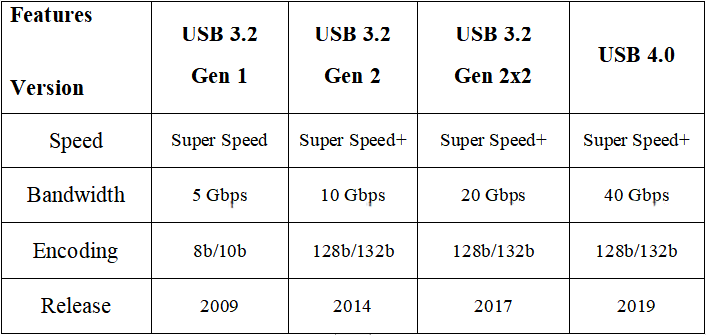Full Introduction To USB 4.0
USB 4.0, released on 29 August 2019 by USB Implementers Forum, is a Universal Serial Bus system specified in the USB4 specification.
Compared with prior USB systems, USB4 still uses USB-C connectors and requires the support of USB PD for power delivery. It is an excellent improvement of the Thunderbolt 3 connector.
USB 4.0 VS USB 3.2
As the latest version, USB 4.0 differs from USB 2.0 in speed, bandwidth, and release time. Just as the chart shows:

USB4 supports 40 Gbit/s throughput. Compared with USB 3.2, when sending mixed data, USB4 can offer higher effective data rates. Based on the Thunderbolt 3 protocol, USB4 support to interoperate with Thunderbolt 3 products, which makes it optional for USB4 peripheral devices and USB4 hosts. In a nutshell, USB 4.0 has made progress in many aspects.
Thunderbolt Compatibility
Apple initially deployed the Intel-designed Thunderbolt fast data transfer tech. Currently, more than 400 PCs on the market are equipped with Thunderbolt 3. The USB-C port can be a Thunderbolt port now. But not all devices have Thunderbolt, and some ports aren’t compatible with Thunderbolt.
Hence, in terms of super-fast data transfer, all USB 4.0 devices and ports are automatically compatible with Thunderbolt only if individual manufacturers elect to build it in. And despite the use of the standard, the use of the trademark is not royalty-free. OEMs need to be certified by Intel so that they can advertise their devices as Thunderbolt 3 compatible.
Benefits
In contrast with prior versions, there are three main benefits of USB4:
- HigherSpeed: Some devices can operate at a maximum speed of 40 Gbps by using two-lane cables, the same as Thunderbolt 3.
- Compatibility: Some devices can work with Thunderbolt 3 devices.
- Better Resource Allocation for Video: The port will allocate bandwidth accordingly when using a USB 4 port to transfer both video and data at the same time. Thus, if the video requires only 20% of the bandwidth to drive the 1080p monitor (also a hub), the other 80% of the bandwidth will transfer the file free of charge from the external SSD.
Sum-it Up!
Please visit this Technology Inn for more about USB 4.0.
